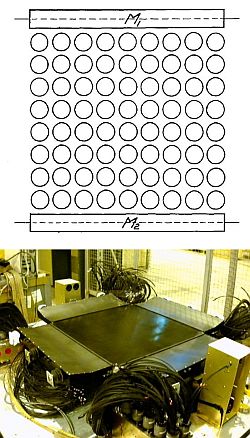 Hodoscope
Hodoscope

An hodoscope is an instrument used in particle physics experiments to detect passing charged particles and determine their trajectories. Its name comes from the Greek where "hodos" stands for way or path, and "skopos" for observer.
The first hodoscope, was designed and built by Dr. Thomas H. Johnson and Dr. E. C. Stevenson of the Bartol Research Foundation of the Franklin Institute and was presented in 1933 at the World's Fair in Chicago. That first model (whose scheme is depicted in the image at left) used neon lamps to reveal the particle's path. M1 and M2 were the detectors used to determine when a single energetic particle (cosmic ray) has penetrated the entire device. If both detectors fired at nearly the same time, then the tubes in the array were allowed to fire and light their constituent bulbs in the devices display.
Modern hodoscopes are characterized by being made up of many segments. The typical detector segment is formed by a piece of scintillating material, which emits light when a particle passes through it. The scintillation light can be converted to an electrical signal either by a photomultiplier tube (PMT) or a PIN diode.
Besides Hodoscopes are some of the simplest devices for tracking charged particles, they are often used in huge layers of hundred of fibers, and combined with other elements for the detection of particles (calorimeters, time of flight devices, or cerenkov detectors). Along with redundant and very fast logical electronic circuits more complex measurements can be performed, not only on the direction of the particles under study but about their charge and amount of energy.
Hodoscopes are a fundamental part of state-of-the-art balloon-borne instruments devoted to detect high energy or rare particles, specially in long duration flights. Some examples of their use can be encountered on experiments like CREAM (Cosmic Ray Energetics And Mass), TIGER (Trans Iron Galactic Element Recorder) or BESS (Balloon-borne Experiment with Superconducting Spectrometer) to name a few.

